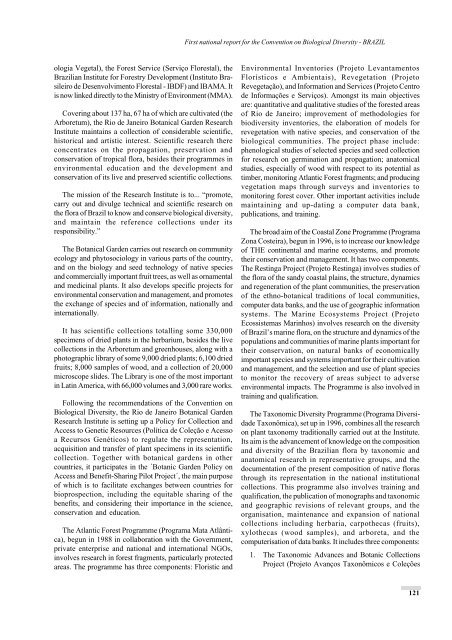Brazil (Part VIII, English version) - Convention on Biological Diversity
Brazil (Part VIII, English version) - Convention on Biological Diversity
Brazil (Part VIII, English version) - Convention on Biological Diversity
- No tags were found...
You also want an ePaper? Increase the reach of your titles
YUMPU automatically turns print PDFs into web optimized ePapers that Google loves.
First nati<strong>on</strong>al report for the <str<strong>on</strong>g>C<strong>on</strong>venti<strong>on</strong></str<strong>on</strong>g> <strong>on</strong> <strong>Biological</strong> <strong>Diversity</strong> - BRAZILologia Vegetal), the Forest Service (Serviço Florestal), the<str<strong>on</strong>g>Brazil</str<strong>on</strong>g>ian Institute for Forestry Development (Instituto Brasileirode Desenvolvimento Florestal - IBDF) and IBAMA. Itis now linked directly to the Ministry of Envir<strong>on</strong>ment (MMA).Covering about 137 ha, 67 ha of which are cultivated (theArboretum), the Rio de Janeiro Botanical Garden ResearchInstitute maintains a collecti<strong>on</strong> of c<strong>on</strong>siderable scientific,historical and artistic interest. Scientific research therec<strong>on</strong>centrates <strong>on</strong> the propagati<strong>on</strong>, preservati<strong>on</strong> andc<strong>on</strong>servati<strong>on</strong> of tropical flora, besides their programmes inenvir<strong>on</strong>mental educati<strong>on</strong> and the development andc<strong>on</strong>servati<strong>on</strong> of its live and preserved scientific collecti<strong>on</strong>s.The missi<strong>on</strong> of the Research Institute is to... “promote,carry out and divulge technical and scientific research <strong>on</strong>the flora of <str<strong>on</strong>g>Brazil</str<strong>on</strong>g> to know and c<strong>on</strong>serve biological diversity,and maintain the reference collecti<strong>on</strong>s under itsresp<strong>on</strong>sibility.”The Botanical Garden carries out research <strong>on</strong> communityecology and phytosociology in various parts of the country,and <strong>on</strong> the biology and seed technology of native speciesand commercially important fruit trees, as well as ornamentaland medicinal plants. It also develops specific projects forenvir<strong>on</strong>mental c<strong>on</strong>servati<strong>on</strong> and management, and promotesthe exchange of species and of informati<strong>on</strong>, nati<strong>on</strong>ally andinternati<strong>on</strong>ally.It has scientific collecti<strong>on</strong>s totalling some 330,000specimens of dried plants in the herbarium, besides the livecollecti<strong>on</strong>s in the Arboretum and greenhouses, al<strong>on</strong>g with aphotographic library of some 9,000 dried plants; 6,100 driedfruits; 8,000 samples of wood, and a collecti<strong>on</strong> of 20,000microscope slides. The Library is <strong>on</strong>e of the most importantin Latin America, with 66,000 volumes and 3,000 rare works.Following the recommendati<strong>on</strong>s of the <str<strong>on</strong>g>C<strong>on</strong>venti<strong>on</strong></str<strong>on</strong>g> <strong>on</strong><strong>Biological</strong> <strong>Diversity</strong>, the Rio de Janeiro Botanical GardenResearch Institute is setting up a Policy for Collecti<strong>on</strong> andAccess to Genetic Resources (Política de Coleção e Acessoa Recursos Genéticos) to regulate the representati<strong>on</strong>,acquisiti<strong>on</strong> and transfer of plant specimens in its scientificcollecti<strong>on</strong>. Together with botanical gardens in othercountries, it participates in the ´Botanic Garden Policy <strong>on</strong>Access and Benefit-Sharing Pilot Project´, the main purposeof which is to facilitate exchanges between countries forbioprospecti<strong>on</strong>, including the equitable sharing of thebenefits, and c<strong>on</strong>sidering their importance in the science,c<strong>on</strong>servati<strong>on</strong> and educati<strong>on</strong>.The Atlantic Forest Programme (Programa Mata Atlântica),begun in 1988 in collaborati<strong>on</strong> with the Government,private enterprise and nati<strong>on</strong>al and internati<strong>on</strong>al NGOs,involves research in forest fragments, particularly protectedareas. The programme has three comp<strong>on</strong>ents: Floristic andEnvir<strong>on</strong>mental Inventories (Projeto LevantamentosFlorísticos e Ambientais), Revegetati<strong>on</strong> (ProjetoRevegetação), and Informati<strong>on</strong> and Services (Projeto Centrode Informações e Serviços). Am<strong>on</strong>gst its main objectivesare: quantitative and qualitative studies of the forested areasof Rio de Janeiro; improvement of methodologies forbiodiversity inventories, the elaborati<strong>on</strong> of models forrevegetati<strong>on</strong> with native species, and c<strong>on</strong>servati<strong>on</strong> of thebiological communities. The project phase include:phenological studies of selected species and seed collecti<strong>on</strong>for research <strong>on</strong> germinati<strong>on</strong> and propagati<strong>on</strong>; anatomicalstudies, especially of wood with respect to its potential astimber, m<strong>on</strong>itoring Atlantic Forest fragments; and producingvegetati<strong>on</strong> maps through surveys and inventories tom<strong>on</strong>itoring forest cover. Other important activities includemaintaining and up-dating a computer data bank,publicati<strong>on</strong>s, and training.The broad aim of the Coastal Z<strong>on</strong>e Programme (ProgramaZ<strong>on</strong>a Costeira), begun in 1996, is to increase our knowledgeof THE c<strong>on</strong>tinental and marine ecosystems, and promotetheir c<strong>on</strong>servati<strong>on</strong> and management. It has two comp<strong>on</strong>ents.The Restinga Project (Projeto Restinga) involves studies ofthe flora of the sandy coastal plains, the structure, dynamicsand regenerati<strong>on</strong> of the plant communities, the preservati<strong>on</strong>of the ethno-botanical traditi<strong>on</strong>s of local communities,computer data banks, and the use of geographic informati<strong>on</strong>systems. The Marine Ecosystems Project (ProjetoEcossistemas Marinhos) involves research <strong>on</strong> the diversityof <str<strong>on</strong>g>Brazil</str<strong>on</strong>g>’s marine flora, <strong>on</strong> the structure and dynamics of thepopulati<strong>on</strong>s and communities of marine plants important fortheir c<strong>on</strong>servati<strong>on</strong>, <strong>on</strong> natural banks of ec<strong>on</strong>omicallyimportant species and systems important for their cultivati<strong>on</strong>and management, and the selecti<strong>on</strong> and use of plant speciesto m<strong>on</strong>itor the recovery of areas subject to adverseenvir<strong>on</strong>mental impacts. The Programme is also involved intraining and qualificati<strong>on</strong>.The Tax<strong>on</strong>omic <strong>Diversity</strong> Programme (Programa DiversidadeTax<strong>on</strong>ômica), set up in 1996, combines all the research<strong>on</strong> plant tax<strong>on</strong>omy traditi<strong>on</strong>ally carried out at the Institute.Its aim is the advancement of knowledge <strong>on</strong> the compositi<strong>on</strong>and diversity of the <str<strong>on</strong>g>Brazil</str<strong>on</strong>g>ian flora by tax<strong>on</strong>omic andanatomical research in representative groups, and thedocumentati<strong>on</strong> of the present compositi<strong>on</strong> of native florasthrough its representati<strong>on</strong> in the nati<strong>on</strong>al instituti<strong>on</strong>alcollecti<strong>on</strong>s. This programme also involves training andqualificati<strong>on</strong>, the publicati<strong>on</strong> of m<strong>on</strong>ographs and tax<strong>on</strong>omicand geographic revisi<strong>on</strong>s of relevant groups, and theorganisati<strong>on</strong>, maintenance and expansi<strong>on</strong> of nati<strong>on</strong>alcollecti<strong>on</strong>s including herbaria, carpothecas (fruits),xylothecas (wood samples), and arboreta, and thecomputerisati<strong>on</strong> of data banks. It includes three comp<strong>on</strong>ents:1. The Tax<strong>on</strong>omic Advances and Botanic Collecti<strong>on</strong>sProject (Projeto Avanços Tax<strong>on</strong>ômicos e Coleções121
















